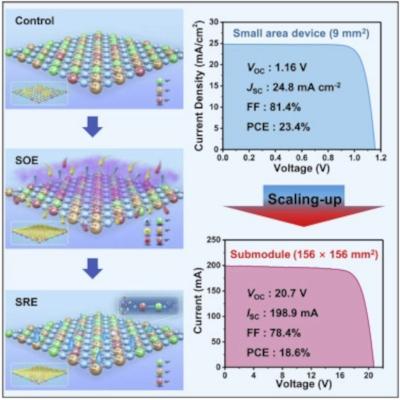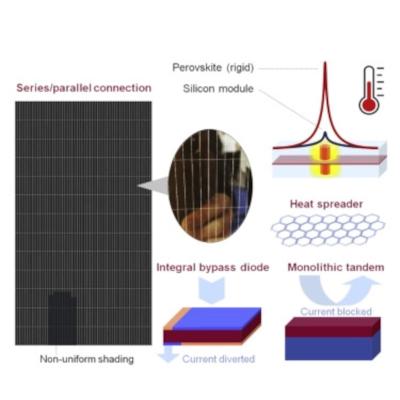Perovskite-Info weekly newsletter
Published: Tue, 08/02/22
The Perovskite-Info newsletter (August 2, 2022)
Cannot read this? View it online here
Researchers study the optical, electronic, and magnetic properties of layered perovskite ceramic compounds
Researchers from Nagoya Institute of Technology in Japan have used a combination of experimental and theoretical methods to better understand the optical, electronic, and magnetic properties of complex solids of layered perovskite compounds. The approach is applicable to a wide range of functionalized crystalline ceramic compounds.
Urban areas without sufficient tree coverage are significantly warmer than their surroundings. This "urban heat island" effect mainly results from an absorption of near-infrared (NIR) radiation in sunlight. NIR-reflective pigments that can mitigate such heating effects are, therefore, highly desirable. In particular, functional inorganic pigments are attractive candidates on this front. In fact, Dr. Ryohei Oka and his colleagues from Nagoya Institute of Technology have demonstrated that layered perovskite ceramic compounds of the type A2BO4 are ideal for reflecting NIR. In his previous study, it was discovered that novel perovskites such as titanium-added calcium manganese oxide (Ca2(Mn,Ti)O4) ceramics are much better at reflecting NIR radiation than commercially available black pigments. However, the mechanism by which Ca2(Mn,Ti)O4 achieves this goal remains unknown.
SETO grant to fund development of method for detecting perovskite defects during manufacturing
The U.S. Department of Energy Solar Energy Technologies Office (SETO) selected University of Arizona chemical and environmental engineering associate professor Erin Ratcliff for a $300,000 grant to advance the near-term scalability of perovskites.
“Perovskites are the highest-performing printable solar cell technology,” Ratcliff said. “But the operating hypothesis in the field is that defects are contributing to instability”. With the SETO grant, Ratcliff and her team will develop a method for detecting these defects during manufacturing. The low-cost, scalable method will help scientists understand the way different parts and materials of the manufacturing process may contribute to defects and instability, and, in turn, how to mitigate these effects. The grant is part of SETO’s Small Innovative Projects in Solar 2022 Funding Program, which funds targeted, early-stage ideas in solar energy research that can produce significant results within the first year of performance. Nineteen projects received a total of $5 million in funding.
Researchers design graphene oxide/silicon heterojunction solar cell with 18.8% efficiency
Researchers from Hebei University, Karlsruhe Institute of Technology and Chinese module manufacturer Yingli Green Energy Holding Co. Ltd. have reported a heterojunction solar cell based on graphene-oxide (GO) and silicon with a large area of 5.5 cm2.
GO is a compound of carbon, oxygen and hydrogen that is obtained by treating graphite with oxidizers and acids. It consists of a single-layer sheet of graphite oxide that is commonly used to produce graphene-related nanomaterials for various applications, including electronics, optics, chemistry and more. The scientists developed an ink made of GO mixed with Nafion, that can be spin-coated on an n-type silicon wafer to form a high-quality passivating contact scheme. “Low interface recombination is provided by the Nafion and carrier selection by the GO,” the team explained, noting that the passivation scheme also includes an electron-selective passivation contact comprising n-doped hydrogenated amorphous silicon with an indium tin oxide (ITO) overlayer aimed at improving light trapping and reducing surface recombination.
Surface redox engineering approach enables high-performance large-area perovskite submodules
Researchers led by Prof. LIU Shengzhong from the Dalian Institute of Chemical Physics (DICP) of the Chinese Academy of Sciences (CAS) have developed a facile surface redox engineering (SRE) strategy for vacuum-deposited NiOx to match the slot-die-coated perovskite, and fabricated high-performance large-area perovskite submodules.

Inverted PSCs could be even more valuable than their normal counterparts because the former have easily-mitigated hysteresis behavior and long-term durability. NiOx has been demonstrated as a promising hole transport material for inverted PSCs. But for most vacuum-processed NiOx films, the relatively hydrophobic surface attenuates the adhesion of perovskite ink, making it challenging to deposit large-area perovskite films.
UNSW team outlines the threat that reverse-bias poses to perovskite solar cells
University of New South Wales (UNSW) team, led by renowned PV scientist Martin Green, have shown that perovskite solar cells may be especially susceptible to damage from reverse bias, caused by uneven shading or other issues that may appear in real-world environments. Both the reverse-bias itself and resulting build up of heat can cause several of the materials commonly used in perovskite solar cells to degrade, and these issues have received only limited attention in research published thus far.

Stability issues with perovskite solar cells linger, despite impressive research achievements in the last few years. Much of the research focused on improving stability to date has focused on the issues that arise under normal operating conditions – for example sensitivity to oxygen and moisture, which can be solved through encapsulation, or degradation under UV light, which can be solved with reflective coatings. Other issues, however, may present serious challenges to developing perovskite devices that can function in outdoor conditions for years and even decades. “…thermal degradation and reverse-bias instability are remaining issues that pose challenges even for intrinsically much more stable silicon cells, suggesting that innovative approaches may be required to satisfactorily address these for perovskite cells”, explain the authors of the new paper.
2D perovskite passivation layer for efficient and stable perovskite solar cells
Researchers from Ulsan National Institute of Science and Technology (UNIST), Wuhan University of Technology and Foshan Xianhu Laboratory of the Advanced Energy Science and Technology Guangdong Laboratory have announced their success in manufacturing a high-efficiency, stable perovskite solar cell through a vacuum thin film deposition process.
Vacuum thin film deposition is a technique that is already widely used in the manufacture of large OLED TVs by evaporating raw materials in a vacuum and coating them thinly on a substrate. The perovskite solar cell developed this way displayed a photovoltaic-to-electricity conversion efficiency of 21.4%, which the team said is the highest among perovskite solar cells manufactured by vacuum thin film deposition process.
Researchers use Polyaniline for improved perovskite solar cells
Scientists from Syracuse University, South Dakota State University and Huzhou University have examined the use of polyaniline as a material for improved perovskite solar cells. The team demonstrated a facile, low-cost fabrication route for polyaniline hole transport mechanisms that display enhanced power conversion efficiency compared to conventional PEDOT:PSS hole transport layers in perovskites. This could provide a route toward low-cost, high-efficiency perovskite solar cells.
PEDOT:PSS is a commonly used material in perovskites, used as a hole transport layer between the photoactive perovskite layer and indium tin oxide layer. Using PEDOT:PSS improves the power conversion efficiency of perovskite solar cells. However, several issues have been observed with PEDOT:PSS. One of the fundamental issues is the degradation of active layers and defect formation associated with the large particle size of this material. Moreover, the use of this material as a hole transport layer is hindered by issues with low electrical conductivity limits and cost.
Metalgrass LTD
9 Har Tsin St.
Kfar Sava Hasharon 4430809
ISRAEL
Unsubscribe | Change Subscriber Options



